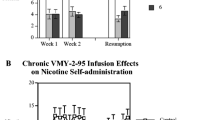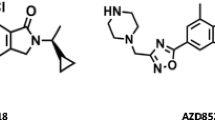Abstract
Rationale
Partial agonists and antagonists of addictive drugs have been useful in the treatment of dependence.
Objective
The purpose of this study is to determine whether nicotine analogs with partial agonist or antagonist properties at α4β2 nicotinic acetylcholine receptors (nAChRs) inhibit self-administration of nicotine in rats.
Materials and methods
Male Sprague–Dawley rats were trained to self-administer nicotine (unit dose 0.017 mg/kg) intravenously contingent upon the completion of five lever presses. Once stable responding was established, rats were administered test agents, either as a subcutaneous injection before the daily session or co-infused with nicotine.
Results
The number of nicotine injections taken per session was reduced to approximately 50% of baseline after either pre-treatment with the broad spectrum nicotinic receptor antagonist, mecamylamine, or by substituting saline for nicotine (extinction). 4′-Trans-methyl-nicotine, a strong partial agonist, inhibited nicotine self-administration and substituted for nicotine to support self-administration. Partial agonists, prepared by substitution at the 1′-N-position with either ethyl or cyclopropylmethyl moieties, potently inhibited self-administration. Antagonists formed by 5′-methyl substitution also inhibited self-administration, with the 5′-trans-methyl enantiomer about ten times more potent than the 5′-cis-methyl enantiomer. In contrast, antagonists formed by aryl substitution at the 5 position of the pyridyl ring of nicotine did not inhibit self-administration. Intravenous co-infusions had similar effects to the pre-injections. In most instances, doses of the analogs that reduced nicotine self-administration had no effect on food intake when measured using a similar FR5 protocol.
Conclusions
Nicotine analogs with α4β2 nAChR partial agonist and antagonist efficacies can inhibit self-administration and may be considered as prototypical smoking-cessation agents.


Similar content being viewed by others
References
Baettig K, Martin JR, Classen W (1980) Nicotine and amphetamine: differential tolerance and cross-tolerance for ingestive effects. Pharmacol Biochem Behav 12:107–111
Besson M, David V, Suarez S, Cormier A, Cazala P, Changeux J-P, Granon S (2006) Genetic dissociation of two behaviors associated with nicotine addiction: beta-2 containing nicotinic receptors are involved in nicotine reinforcement but not in withdrawal syndrome. Psychopharmacology 187:189–199
Caggiula AR, Donny EC, White AR, Chaudhri N, Booth S, Gharib MA, Hoffman A, Perkins KA, Sved AF (2001) Cue dependency of nicotine self-administration and smoking. Pharmacol Biochem Behav 70:515–530
Chiamulera C, Borgo C, Falchetto S, Valerio E, Tessari M (1996) Nicotine reinstatement of nicotine self-administration after long-term extinction. Psychopharmacology 127:102–107
Corrigall WA (1992) A rodent model for nicotine self-administration. In: Boulton A, Baker G, Wu PH (eds) Neuromethods, vol 24: animal models of addiction. Humana, Totowa, New Jersey, pp 315–345
Corrigall WA, Coen KM (1989) Nicotine maintains robust self-administration in rats on a limited-access schedule. Psychopharmacology 99:473–478
Donny EC, Caggiula AR, Knopf S, Brown C (1995) Nicotine self-administration in rats. Psychopharmacology 122:390–394
Donny EC, Caggiula AR, Mielke MM, Jacobs KS, Rose C, Sved A (1998) Acquisition of nicotine self-administration in rats: the effects of dose, feeding schedule, and drug contingency. Psychopharmacology 136:83–90
Donny EC, Caggiula AR, Mielke MM, Booth S, Gharib MA, Hoffman A, Maldovan V, Shupenko C, McCallum SE (1999) Nicotine self-administration in rats on a progressive ratio schedule of reinforcement. Psychopharmacology 147:135–142
Dwoskin LP, Joyce BM, Zheng G, Neugebauer NM, Manda VK, Lockman P, Papke RL, Bardo MT, Crooks PA (2007) Discovery of a novel nicotinic receptor antagonist for the treatment of nicotine addiction: 1-(3-picolinium)-12-triethylammonium-dodecane bromide. Biochem Pharmacol 74:1271–1282
Glick SD, Maisonneuve IM, Kitchen BA (2002) Modulation of nicotine self-administration in rats by combination therapy with agents blocking α3β4 nicotinic receptors. Eur J Pharmacol 448:185–191
Grottick AJ, Trube G, Corrigall WA, Huwyler J, Malherbe P, Wyler R, Higgins GA (2000) Evidence that nicotinic alpha7 receptors are not involved in the hyperlocomotor and rewarding effects of nicotine. J Pharmacol Exp Ther 294:1112–1119
Laviolette SR, van der Kooy D (2003) The motivational valence of nicotine in the rat ventral tegmental area is switched from rewarding to aversive following blockade of the α7-subunit-containing nicotinic acetylcholine receptor. Psychopharmacology 166:306–313
Lerman C, LeSage MG, Perkins KA, O’Malley SS, Siegal SJ, Benowitz NL, Corrigal WA (2007) Translational research in medication development for nicotine dependence. Nature Rev Drug Discovery 6:746–762
Levin ED, Rezvani AH (2007) Nicotinic interactions with antipsychotic drugs, models of schizophrenia and impacts on cognitive function. Biochem Pharmacol 74:1182–1191
Mansbach RS, Chambers LK, Rovetti CC (2000) Effects of the competitive nicotinic antagonist erysodine on behavior occasioned or maintained by nicotine: comparison with mecamylamine. Psychopharmacology 148:234–242
Mineur YS, Picciotto MR (2007) Genetics of nicotine acetylcholine receptors: relevance to nicotine addiction. Biochem Pharmacol 75:323–333
Picciotto MR, Zoli M, Rimondini R, Lena C, Marubio LM, Pich EM, Fuxe K, Changeux JP (1998) Acetylcholine receptors containing the β2 subunit are involved in the reinforcing properties of nicotine. Nature 391:173–177
Shoaib M, Schindler CW, Goldberg SR (1997) Nicotine self-administration in rats: strain and nicotine pre-exposure effects on acquisition. Psychopharmacology 129:35–43
Smith JW, Mogg A, Tafi E, Peacey E, Pullar IA, Szekeres P, Tricklebank M (2007) Ligands selective for alpha4beta2 but not alpha3Beta4 or alpha7 nicotinic receptors generalize to the nicotine discriminative stimulus in the rat. Psychopharmacology 190:157–170
Stairs DJ, Neugebauer NM, Wei X, Boustany C, Hojahmat M, Cassis LA, Crooks PA, Dwoskin LP, Bardo MT (2007) Effects of nornicotine enantiomers on intravenous S(−)-nicotine self-administration and cardiovascular function in rats. Psychopharmacology 190:145–155
Stolerman IP, Jarvis MJ (1995) The scientific case that nicotine is addictive. Psychopharmacology 117:2–10
Stolerman IP, Chamberlain S, Bizarro L, Fernandes C, Schalkwyk L (2004) The role of nicotinic receptor alpha7 subunits in nicotine discrimination. Neuropharmacology 46:363–371
van Haaren F, Anderson KG, Haworth S, Kem WR (1999) GTS-21, a mixed nicotinic receptor agonist/antagonist, does not affect the nicotine cue. Pharmacol Biochem Behav 64:439–444
Watkins SS, Epping-Jordan MP, Koob GF, Markou A (1999) Blockade of nicotine self-administration with nicotinic antagonists in rats. Pharmacol Biochem Behav 62:743–751
Wildeboer KW (2005) Structure activity relationships of nicotine analogs and Erythrina alkaloids on the alpha4beta2 nicotinic acetylcholine receptor. Univ. Florida Ph.D. Dissertation, 107 pp
Yoshimura RF, Hogenkamp DJ, Li WY, Tran MB, Bellizzi JD, Whittemore ER, Leslie FM, Gee KW (2007) Negative allosteric modulation of nicotinic acetylcholine receptors blocks nicotine self-administration in rats. J Pharmacol Exp Ther 323:907–915
Acknowledgments
This research was supported by grant BMO13 (W. Kem, P.I.) from the Florida Biomedical Research Program, administered by the Florida Department of Health.
Author information
Authors and Affiliations
Corresponding author
Rights and permissions
About this article
Cite this article
Rowland, N.E., Robertson, K., Soti, F. et al. Nicotine analog inhibition of nicotine self-administration in rats. Psychopharmacology 199, 605–613 (2008). https://doi.org/10.1007/s00213-008-1186-8
Received:
Accepted:
Published:
Issue Date:
DOI: https://doi.org/10.1007/s00213-008-1186-8




